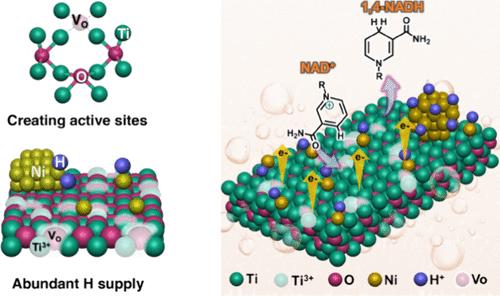当前位置:
X-MOL 学术
›
ACS Sustain. Chem. Eng.
›
论文详情
Our official English website, www.x-mol.net, welcomes your feedback! (Note: you will need to create a separate account there.)
Defect-Driven Optimization of TiO2-Based Electrodes for High-Efficiency Electrochemical 1,4-NADH Generation
ACS Sustainable Chemistry & Engineering ( IF 7.1 ) Pub Date : 2024-06-20 , DOI: 10.1021/acssuschemeng.4c02313 Nada H. A. Besisa 1 , Ki-Seok Yoon 2 , Tomohiro Goroh Noguchi 3 , Hirokazu Kobayashi 4 , Miho Yamauchi 1, 2, 3, 4, 5
ACS Sustainable Chemistry & Engineering ( IF 7.1 ) Pub Date : 2024-06-20 , DOI: 10.1021/acssuschemeng.4c02313 Nada H. A. Besisa 1 , Ki-Seok Yoon 2 , Tomohiro Goroh Noguchi 3 , Hirokazu Kobayashi 4 , Miho Yamauchi 1, 2, 3, 4, 5
Affiliation

|
The electrochemical reduction of nicotinamide adenine dinucleotide (NAD) using water as a hydrogen source is a promising strategy for the efficient and environmentally friendly production of the active enzymatic cofactor 1,4-NADH, which is a key for the further application of enzymatic systems in various industrial fields. However, the efficient regeneration of 1,4-NADH (NADH-reg) remains a major challenge. The rate-limiting step in the electrochemical conversion of the oxidized NAD is the second electron transfer to an NAD radical, which is formed by the reduction of NAD+, at a large overpotential, whereas the other side reactions proceed readily. To surmount this obstacle and promote NADH-reg, we used Ni nanoparticle-loaded TiO2 on a Ti electrode (Ni-TOT) containing a sufficient number of defects as active sites, which are formed at 300 °C in the H2 atmosphere. Ni-TOT facilitated the formation of enzymatically active 1,4-NADH with a superior yield and significantly reduced overpotential compared to those on untreated TOT. We found that hydrogen spillover promotes the formation of active sites on Ni-TOT. This study highlights the potential of engineered defect-enriched electrodes as a means to advance NADH-reg.
中文翻译:

用于高效电化学 1,4-NADH 生成的 TiO2 基电极的缺陷驱动优化
以水为氢源电化学还原烟酰胺腺嘌呤二核苷酸(NAD)是一种高效、环保生产活性酶辅因子 1,4-NADH 的有前景的策略,也是酶系统进一步应用的关键。各个工业领域。然而,1,4-NADH(NADH-reg)的有效再生仍然是一个重大挑战。氧化NAD电化学转化的限速步骤是在较大的过电势下,第二次电子转移到NAD自由基,该自由基是由NAD + 还原形成的,而其他副反应则进行容易。为了克服这一障碍并促进 NADH-reg,我们在含有足够数量的缺陷作为活性位点的 Ti 电极(Ni-TOT)上使用了负载 Ni 纳米粒子的 TiO 2 ,该电极在 300 °C 下形成在 H 2 气氛中。与未经处理的 TOT 相比,Ni-TOT 促进了具有酶活性的 1,4-NADH 的形成,产量较高,并且显着降低了过电势。我们发现氢溢出促进了 Ni-TOT 上活性位点的形成。这项研究强调了工程缺陷富集电极作为推进 NADH-reg 的一种手段的潜力。
更新日期:2024-06-20
中文翻译:

用于高效电化学 1,4-NADH 生成的 TiO2 基电极的缺陷驱动优化
以水为氢源电化学还原烟酰胺腺嘌呤二核苷酸(NAD)是一种高效、环保生产活性酶辅因子 1,4-NADH 的有前景的策略,也是酶系统进一步应用的关键。各个工业领域。然而,1,4-NADH(NADH-reg)的有效再生仍然是一个重大挑战。氧化NAD电化学转化的限速步骤是在较大的过电势下,第二次电子转移到NAD自由基,该自由基是由NAD + 还原形成的,而其他副反应则进行容易。为了克服这一障碍并促进 NADH-reg,我们在含有足够数量的缺陷作为活性位点的 Ti 电极(Ni-TOT)上使用了负载 Ni 纳米粒子的 TiO 2 ,该电极在 300 °C 下形成在 H 2 气氛中。与未经处理的 TOT 相比,Ni-TOT 促进了具有酶活性的 1,4-NADH 的形成,产量较高,并且显着降低了过电势。我们发现氢溢出促进了 Ni-TOT 上活性位点的形成。这项研究强调了工程缺陷富集电极作为推进 NADH-reg 的一种手段的潜力。
















































 京公网安备 11010802027423号
京公网安备 11010802027423号